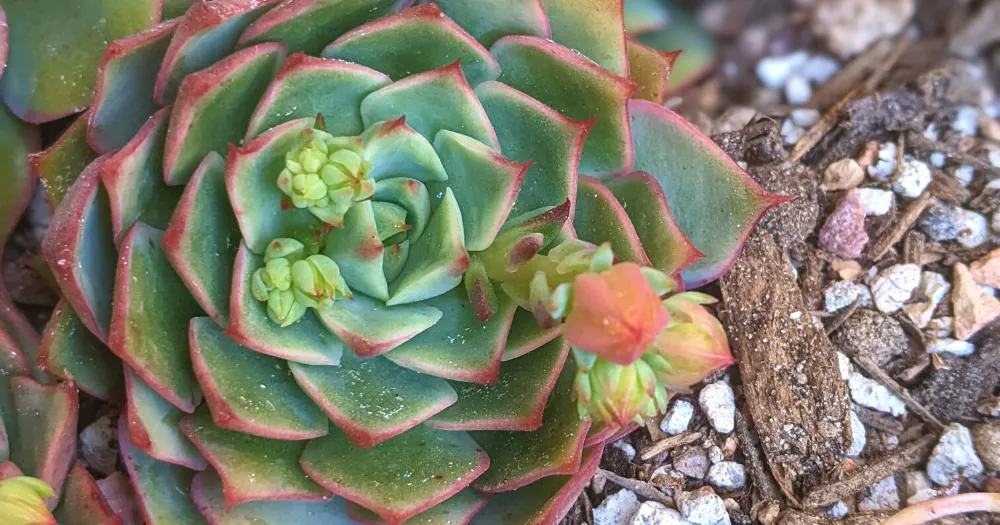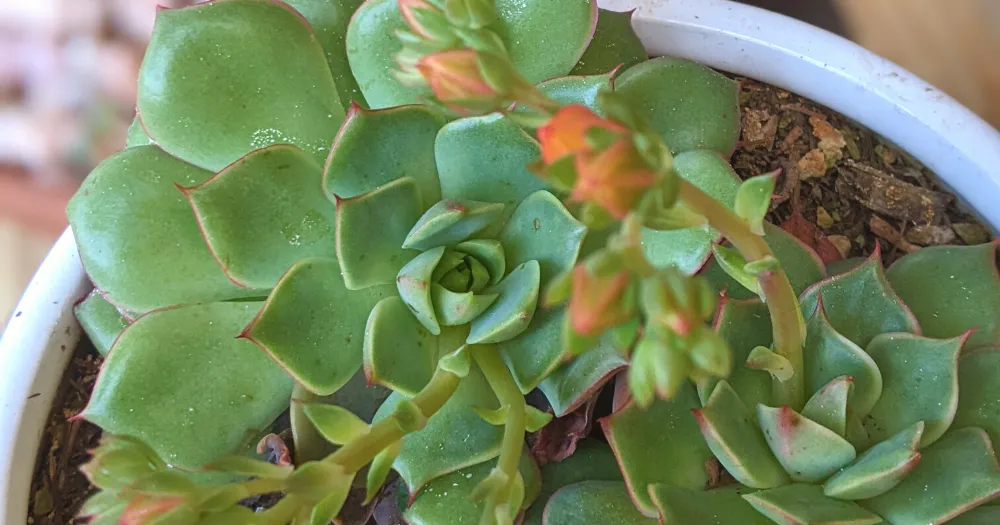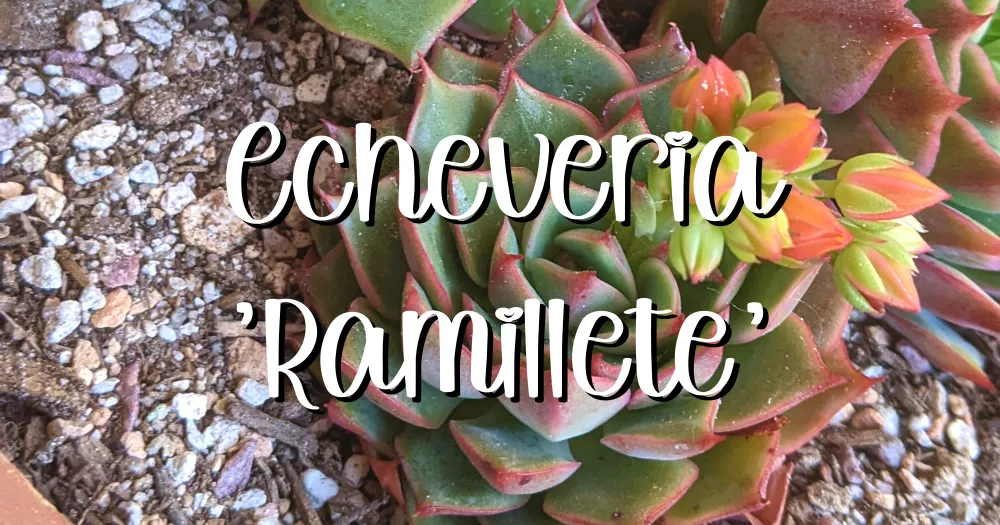Echeveria ‘Ramillete’ is a stunning succulent plant that belongs to the Crassulaceae family. It is highly sought after for its attractive rosette shape, unique foliage patterns, and beautiful flowers. In this comprehensive care guide, we will delve into all aspects of caring for Echeveria ‘Ramillete’, including its appearance, preferred growing conditions, propagation methods, potential problems, and more.
Dig in!

Appearance and Size
Echeveria ‘Ramillete’ is characterized by its rosette-shaped leaves that grow in a compact manner. The leaves are fleshy, thick, and have a stunning blue-green color, often with reddish or pinkish edges. The rosettes can reach a diameter of about 4 to 6 inches (10 to 15 cm), making it a relatively small succulent.

Flowers
Echeveria ‘Ramillete’ produces beautiful bell-shaped flowers on long stalks. The flowers are typically coral or pink in color and bloom in the late spring or early summer. The blooming period can last for several weeks, adding a vibrant touch to your succulent collection.

Echeveria ‘Ramillete’ Care Guide
Light Requirements
Echeveria ‘Ramillete’ thrives in bright, indirect light. It is best to place it near a window where it can receive plenty of sunlight. However, be cautious of intense, direct sunlight as it can cause sunburn on the leaves. If you notice the leaves turning brown or scorched, move the plant to a slightly shadier location.

Watering
As with most succulents, Echeveria ‘Ramillete’ prefers a well-draining soil and infrequent watering. Allow the soil to dry out completely between watering sessions. During the summer months, water the plant thoroughly, ensuring that excess water drains out of the pot. In winter, reduce watering to once every few weeks, as the plant goes into a dormant state.
Soil Requirements
Echeveria ‘Ramillete’ requires a well-draining soil mixture to prevent root rot. A combination of cactus or succulent soil with perlite or pumice works well. This mixture allows water to drain quickly, preventing waterlogged conditions that can be detrimental to the plant’s health.

Temperature Tolerance
Echeveria ‘Ramillete’ is a hardy succulent that can tolerate a wide range of temperatures. It can withstand temperatures as low as 25°F (-4°C) but prefers temperatures between 50°F to 80°F (10°C to 27°C). Protect the plant from frost and extreme heat to ensure its well-being.
USDA Hardiness Zone
The ideal USDA hardiness zone for growing Echeveria ‘Ramillete’ outdoors is 9 to 11. In these zones, the plant can thrive and survive the winter months without much difficulty. However, it can also be grown in other zones as long as proper care is provided.
Fertilizer
Echeveria ‘Ramillete’ benefits from a balanced fertilizer formulated specifically for succulents. During the active growing season, which is typically spring and summer, feed the plant every two to four weeks. Dilute the fertilizer to half the recommended strength to avoid overfertilization, which can lead to leaf burn.
Repotting
Echeveria ‘Ramillete’ does not require frequent repotting. It is generally recommended to repot the plant every two to three years or when it outgrows its current container. Choose a pot that is slightly larger than the current one and use fresh, well-draining soil when repotting.
When you’re rooting or transplanting your succulents and cacti, use SUPERthrive to help reduce the chance of transplant shock and grow a strong root system.
Propagation
The easiest way to propagate Echeveria ‘Ramillete’ is through leaf or stem cuttings. To propagate from leaves, gently twist a healthy leaf from the base of the plant and allow it to callus over for a few days. Place the callused end into a well-draining soil mix and mist lightly until roots and new growth start to appear. Stem cuttings can be taken from the main rosette and treated similarly. Ensure that the cuttings are allowed to dry out and form calluses before planting.

Pests and Diseases
Echeveria ‘Ramillete’ is generally resilient to pests and diseases. However, it can occasionally attract common succulent pests such as mealybugs, aphids, and spider mites. Regularly inspect the plant for any signs of infestation and treat them promptly using organic insecticidal soaps or neem oil. Avoid overwatering and provide adequate air circulation to prevent fungalinfections. If you notice any signs of rot or discoloration on the leaves, it may be an indication of overwatering or poor drainage.
Fix the pest problem on your succulents and cacti with these popular insecticides.
Tips for Success
Here are some additional tips to help you successfully care for Echeveria ‘Ramillete’:
- Avoid overwatering: Succulents, including Echeveria ‘Ramillete’, are prone to root rot if overwatered. Always allow the soil to dry out completely between watering sessions.
- Provide proper drainage: Ensure that your pot has drainage holes to allow excess water to escape. This prevents water from pooling at the bottom and causing root rot.
- Protect from extreme temperatures: While Echeveria ‘Ramillete’ can tolerate a wide range of temperatures, it is best to protect it from extreme heat or frost. Consider moving the plant indoors during extreme weather conditions.
- Maintain good air circulation: Proper air circulation helps prevent fungal infections and keeps the plant healthy. Avoid overcrowding your succulent collection and provide space between plants.
- Observe and adjust: Pay attention to the appearance of your Echeveria ‘Ramillete’. If you notice any changes in color, texture, or growth, it may be a sign that the plant needs adjustments in its care routine.
Echeveria ‘Ramillete’ is a visually striking succulent that adds beauty to any indoor or outdoor space. By following the care guidelines outlined in this comprehensive guide, you can ensure that your Echeveria ‘Ramillete’ thrives and remains healthy. Remember to provide it with proper lighting, well-draining soil, infrequent watering, and protection from extreme temperatures. With the right care, you can enjoy the beauty of Echeveria ‘Ramillete’ for years to come.









